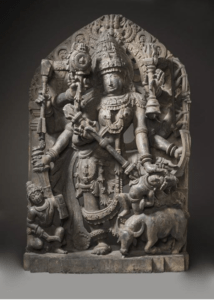- This topic is empty.
-
AuthorPosts
-
April 11, 2023 at 5:17 pm #1125Up::7
The traditional views track down the origin of the Hindu religion to the Vedas. Each Veda comprises four different texts, composed at different times; Samhitas(mantras), Brahmanas(directions regarding the conduction of rituals),Aranyakas( esoteric texts studied in forests isolation), and Upanisads(metaphysical discourses on Atma and Brahma), are the constituents composing Veda.
Though, at present time most of us are left perplexed at a suggestions that our religion could have sprung many centuries earlier in the Indus Valley period. The Rigveda does not specifically describes gods in human form nor does it mentions image worship but does contain instances where Rishi hints at human attributes in gods as during Rigvedic time gods were worshipped as divine forces.
Theories explaining why society with portable religious practices (yajana) made a transition to Murti puja involving fixity and construction of temples.
It seems inconceivable that the concept of murti puja is sudden development. Although the idea of devas with human-like sensory organs and human appearance is well-found in the Brhad-Aranyaka Upanishad section 2.2, Kena Upanishad section 1.4. However, the theory that murti puja predated the Vedic period which is evidenced well by uncovering of an ithphyallic figurine(Of or pertaining to an upward pointing, erect penis; (specifically) of an artistic depiction of a deity or other figure) in Mohenjo-daro and various stone representing emblems.

As the concept of the murti puja is, it is believed that since the early Vedic period the concept of physical manifestations and appearance had been there, and religion is quite comfortable with both visible and invisible gods.
There is corroboration in the Vedic history about worship which could be Saguna and Nirguna– supreme with or without attributes. Worshiping in temple is saguna where the lord is represented by material such as stones,and woods which does not mean the material nature but the absolute nature of the supreme.
As for devotees, there is no labour in approaching the supreme directly but for those who follows an impersonal ways. They have to acknowledge manifested portrayal of the supreme through vedic literature as Upanisads, languages, and non-perceptual feelings which is quite difficult for an individual to process.
A passage comes into view in Srimad-Bhagvatam which says, if one instead of surrendering unto the supreme follows and takes the path to understand what is Brhaman and what is not and spends his whole life in that way, the result is simply problematic and at a time practice in impersonalism become a crisis as he cannot give up the idea. However, for every living individual, the process of realization and consciousness entails engagement in devotional service is the best way and if one ignores this way of service there is imperilment of turning into atheism.
Gita seventh chapter 21 verse includes shlok which translates as-
“I am in everyone’s heart as the Supersoul. As soon as one desires to worship some demigod, I make his faith steady so that he can devote himself to the particular deity.”
Shilp Shastras which means the science of Shilp (art, craft) Hindu texts which instructs rules and principles. Explanation, significance and recommendation of specific mantras to evoke and invoke mightiness are well found in Agamas and Tantras, explaining the tradition which involves installation of murti through prana pratishta where mantras are read aloud, meant to help and to guide an individual towards ultimate realisation, not to portray murtis as having just human forms or human attributes.
Attachments:
You must be logged in to view attached files. -
AuthorPosts
- You must be logged in to reply to this topic.